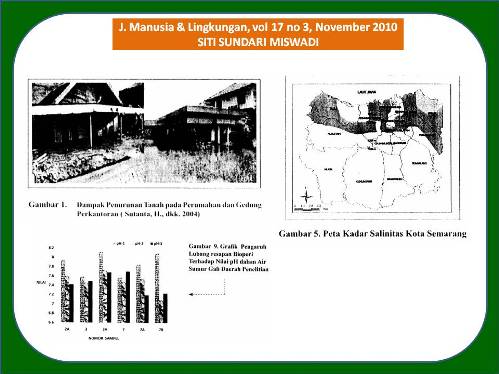
PENURUNAN TINGKAT INTRUSI AIR LAUT BERDASARKAN "CHLORIDE BICARBONATE RATIO" MENGGUNAKAN LUBANG RESAPAN BIOPORI : STUDI KASUS DI KOTA SEMARANG (Decreased of Sea Water Intrusion Based On “Chloride-Bicarbonater Ratio”Using the Biopore Absorption Hole)
Siti Sundari Miswadi(1*)
(1) Pusat Penelitian Kependudukan, Gender dan Lingkungan Hidup, Lembaga Penelitian dan Pengabdian Pada Masyarakat UNNES
(*) Corresponding Author
Abstract
ABSTRAK
Banjir menjadi agenda tahunan bagi warga yang tinggal di daerah pinggiran pantai di Kota Semarang. Namun sekarang, wilayah yang jauh dari pantaipun kini sudah tidak luput dari banjir dan intrusi air laut. Hal ini terjadi karena airtanah sudah melebihi besarnya pengisian kembali (recharge), dan tanah sudah kehilangan fungsinya dalam menyerap air akibat maraknya pembangunan gedung dan perumahan yang tidak ramah lingkungan. Penelitian ini bertujuan untuk memetakan tingkat intrusi air laut di sumur-sumur gali berdasarkan "Chloride-Bicarbonate Ratio", dan daya hantar listrik (DHL) serta salinitas di Kota Semarang. Penelitian dilakukan terhadap 30 sumur gali milik penduduk dengan jarak dari pantai antara 0,5-5 (lima) kilometer. Tingkat intrusi air laut dihitung berdasarkan rasio klorida terhadap karbonat dan bikarbonat, dan hasilnya diplotkan pada peta dasar. Hasil penelitian menunjukkan, tingkat intrusi air laut dan nilai DHL di Kota Semarang bagian timur jauh lebih jelek dibandingkan dengan wilayah pantai sebelah barat Kota Semarang, sedangkan kadar salinitas di sebagian besar daerah penelitian rata-rata kadarnya sedang. Hasil penelitian menggunakan lubang resapan biopori (LRB) sebagai adsorben menunjukkan, pada minggu ketiga setelah pembuatan LRB didapatkan tingkat intrusi air laut naik sebesar 66,64 % sumur, dan sebanyak 33,33% sumur turun tingkat intrusinya, sedangkan pada mingggu keenam terjadi penurunan tingkat intrusi sebesar 66,64% sumur, dan 33,33% sumur naik. Kadar salinitas pada minggu ketiga turun sebanyak 83,30 %sumur, dan 16,66% tetap, sedangkan pada minggu keenam 49,90 % sumur salinitasnya naik, 33,33% turun, dan 16,66% tetap. Nilai daya hantar tistrik (DHL) pada minggu ketiga terdeteksi 16,66% sumur naik, dan 83,30% sumur turun, sedangkan pada minggu keenam 49,98 % sumur DHL-nya naik, dan 49,98% turun. Nilai pH pada minggu ketiga terdeteksi 100% sumur turun, sedangkan minggu kelima) 66,64 % turun dan 33,33 % sumur pHnya naik. Kadar N03 menunjukkan pada minggu ketiga dan minggu keenam didapatkan hasil yang sarna, yaitu 16,66% sumur naik, dan 83,30 % turun. Kadar PO43- pada minggu ketiga lerdeteksi sebesar 100% jumlah sumur turun, sedangkan pada minggu keenam 16,66% turun, dan 83,30 % naik. Nilai kekeruhan pada minggu ketiga terdeteksi 16,66% sumur naik, dan 83,30 % turun, sedangkan pada minggu keenam 49,98 % sumur naik kekeruhannya, dan 49,98 % turun. Berdasarkan hasil penelitian dapat disimpulkan, setelah penggunaan LRB pada minggu ketiga, sebanyak 82,41 % sumur mengalami penurunan dan 17,59% mengalami kenaikan pada ketujuh parameter, sedangkan pada minggu keenam sebanyak 54,75% sumur mengalami penurunan, dan 45,25 % sumur mengalami kenaikan pada ketujuh parameter. Hasil optimal penggunaan LRB sebagai adsorben diperoleh pada minggu keenam.
ABSTRACT
Flood becomes annual agenda for the people who live in the coastal area of Semarang. But now, the regions which far from the coast are now no longer free from the flood and sea water intrusion. It happens because the water already exceeds the amount of soil replenishment (recharge), and the land has lost its function in absorbing water due to uncontrolled construction of buildings and housing which are not environmentally friendly. This study aims to map the level of sea water intrusion in the dug wells based on “Chloride-Bicarbonate Ratio”, and electrical conductivity (DHL) and salinity in the city of Semarang. Research conducted on 30 dug wells owned by residents of the distance from the coast between 0,5-5 (five) kilometers. Sea water intrusion rate was calculated based on the ratio of chloride to carbonate and bicarbonate, and the results were plotted on base maps. The results showed the level of sea water intrusion and the value of DHL in the eastern part of Semarang city much worse than the west coast area of Semarang, while the levels of salinity in most areas of research were in average levels. The results of studies using the Biopore Absorption Hole (LRB) as an absorbent showed during the third week after the construction of LRB, it was acquired that the sea water intrusion rates increased by 66.64% wells, and as many 33.33% wells decreased, whereas at the sixth week the sea water intrusion rates of 66.64% wells decreased whether 33.33% wells increased. Levels of salinity in the third week of 83.30% wells decreased, and 16.66% wells remained the same, whereas in the sixth week the salinity level of 49.90% wells increased, 33.33% wells decreased and 16.66% wells remained the same. Electrical conductivity (DHL) in the third week was detected to increase in 16.66% wells, and decrease in 83.30% wells, while the sixth week, the DHL in 49.98% wells increased and 49.98% wells decreased. pH value in the third week was detected to decrease in 100% wells, while in the sixth week, the pH value decreased in 66.64% wells and 33.33% wells increased. Levels of NO3- in the third week and sixth week obtained the same results, which were 16.66% wells increased and 83.30% wells decreased. PO43- levels in the third week was detected for 100% of the wells decreased, while the sixth week 16.66% wells decreased and 83.30% wells increased. Turbidity value in the third week was detected to increase in 16.66% wells and 83.30% wells decreased, while the sixth week 49.98% wells increased in their turbidity and 49.98% wells decreased. Based on the research, it can be concluded that after the use of LRB in the third week, as many 82.41% wells decreased and 17.59% wells increased in the seven parameters, while in the sixth week as many 54.75% wells decreased and 45.25% wells increased in seven parameters. Optimal results of LRB usage as absorbent were obtained in the sixth week.
Full Text:
ARTIKEL LENGKAP (PDF) (Bahasa Indonesia)Article Metrics
Refbacks
- There are currently no refbacks.
Copyright (c) 2017 Jurnal Manusia dan Lingkungan







